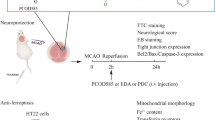Abstract
Caspase-12 has been localized to endoplasmic reticulum (ER) and showed to involve ER stress-induced apoptosis. In the present work we investigated the temporospatial alterations of caspase-12 immunoreactivity in the penumbra following cerebral ischemia/reperfusion in rabbit. Transient cerebral ischemia was produced by intraluminal occlusion of the middle cerebral artery for 2 h followed by 1 h, 6 h, 1 day, 3 days, 7 days and 14 days of reperfusion. Caspase-12 immunohistochemistry was first increased in the penumbra 1 h after reperfusion, with a peak at day 1 to day 3, and then gradually decreased to basal level at day 14. The number of TUNEL-positive cells and ultrastructural observation of brain sections in the penumbra showed a similar change at the same time points. ER mediated by caspase-12 participated in apoptosis induced by cerebral ischemia/reperfusion injury, which may provide a new area for therapeutic intervention to ameliorate outcomes following cerebral ischemia.




Similar content being viewed by others
References
Rao RV, Ellerby HM, Bredesen DE (2004) Coupling endoplasmic reticulum stress to the cell death program. Cell Death Differ 11:372–380
Kumar R, Krause GS, Yoshida H et al (2003) Dysfunction of the unfolded protein response during global brain ischemia and reperfusion. J Cereb Blood Flow Metab 23:462–471
Paschen W, Doutheil J (1999) Disturbances of the functioning of endoplasmic reticulum: a key mechanism underlying neuronal cell injury? J Cereb Blood Flow Metab 19:1–18
Tajiri S, Oyadomari S, Yano S et al (2004) Ischemia-induced neuronal cell death is mediated by the endoplasmic reticulum stress pathway involving CHOP. Cell Death Differ 11:403–415
Nakagawa T, Zhu H, Morishima N et al (2000) Caspase-12 mediates endoplasmic-reticulum-specific apoptosis and cytotoxicity by amyloid-beta. Nature 403:98–103
Mouw G, Zechel JL, Gamboa J et al (2003) Activation of caspase-12, an endoplasmic reticulum resident caspase, after permanent focal ischemiain rat. Neuro Report 14:183–186
Mouw G, Zechel JL, Zhou Y et al (2002) Caspase-9 inhibition after focal cerebral ischemia improves outcome following reversible focal ischemia. Metab Brain Dis 17:143–151
Shibata M, Hattori H, Sasaki T (2003) Activation of caspase-12 by endoplasmic reticulum stress induced by transient middle cerebral artery occlusion in mice. Neuroscience 118:491–499
Yang JP, Liu XF, Liu HJ et al (2008) Extracellular signal-regulated kinase involved in NGF/VEGF-induced neuroprotective effect. Neurosci Lett 434:212–217
Nabavi DG, Cenic A, Henderson S et al (2001) Perfusion mapping using computed tomography allows accurate prediction of cerebral infarction in experimental brain ischemia. Stroke 32:175–183
Manabat C, Han BH, Wendland M et al (2003) Reperfusion differentially induces caspase-3 activation in ischemic core and penumbra after stroke in immature brain. Stroke 34:207–213
Linnik MD, Miller JA, Sprinkle-Cavallo J et al (1995) Apoptosis DNA fragmentation in the rat cerebral cortex induced by permanent middle cerebral artery occlusion. Mol Brain Res 32:116–124
Korde AS, Pettigrew LC, Craddock SD et al (2005) The mitochondrial uncoupler 2, 4-dinitrophenol attenuates tissue damage and improves mitochondrial homeostasis following transient focal cerebral ischemia. J Neurochem 94:1676–1684
Lo EH, Dalkara T, Moskowitz MA (2003) Mechanisms, challenges and opportunities in stroke. Nat Rev Neurosci 4:399–415
Unal-Cevik I, Kilinc M, Can A et al (2004) Apoptotic and necrotic death mechanisms are concomitantly activated in the same cell after cerebral ischemia. Stroke 35:2189–2194
Rao V, Poksay KS, Castro-Obregon S et al (2004) Molecular components of a cell death pathway activated by endoplasmic reticulum stress. J Biol Chem 279:177–187
Yoneda T, Imaizumi K, Oono K et al (2001) Activation of caspase-12, an endoplastic reticulum (ER) resident caspase, through tumor necrosis factor receptor-associated factor 2-dependent mechanism in response to the ER stress. J Biol Chem 276:13935–13940
Acknowledgments
This study was supported by China Ministry of Health Science Foundation (#200310, Dr. Liu), Hebei Natural Science Foundation (#C2006000927, Dr. Liu). China Postdoctor Science Foundation (#20070411051, Dr. Yang).
Author information
Authors and Affiliations
Corresponding author
Rights and permissions
About this article
Cite this article
Liu, Hj., Yang, JP., Wang, CH. et al. Endoplasmic reticulum in the penumbra following middle cerebral artery occlusion in the rabbit. Neurol Sci 30, 227–232 (2009). https://doi.org/10.1007/s10072-009-0086-y
Received:
Accepted:
Published:
Issue Date:
DOI: https://doi.org/10.1007/s10072-009-0086-y




